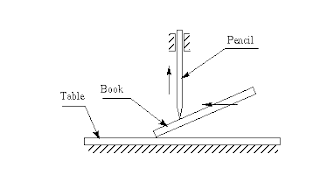We discussed:
* gears and gear trains used in clocks, for example;
* belt and chain drives (as in bikes);
* cams and followers
* and linkages
I am especially interested in cams and followers because they operate on a very simple logic, yet can be used in a variety of ways to transfer rotational motion to linear or another form.
Cams and followers (as the name suggests) consist of two main parts: i) cams drive the motion (by rotating about a fixed axis, for example) while brushing against followers; ii) followers are pushed to varying degrees based on the dimension and motion of cams.
A very simple example of cams and followers can be set up using a book (or any material that can be made into an incline plane) and a pencil.
1) Hold the pencil vertically such that it can only move up or down if force is applied to it.
2) Make an incline out of the book such that it touches the pencil's tip.
3) Now, move the book back and forth and note that the pencil moves either up or down.
The pencil's height increases or decreases based on the height of the point it touches on the book/incline. This is shown in Figure 1 below.
Figure 1: Cam and Follower Experiment with Pencil and Book
Source: https://www.cs.cmu.edu/~rapidproto/mechanisms/chpt6.html#HDR95
By constraining the follower's motion to suit our desired type of movement, we can use cams and followers with amazing flexibility. We can vary the shape of either or both the cam and follower, play with their dimensions, and the motion of the cam. A few examples of the different ways one can utilize cams and followers are:
Figure 2: Grooves and curvy edges used in cams and followers
Source: https://www.cs.cmu.edu/~rapidproto/mechanisms/chpt6.html#HDR95
Figure 3: "Imperfect" circle cams and see-saw followers
Source: http://educypedia.karadimov.info/library/rockeranim.gif
In Figure 3, the side of the follower touching the cam moves up and down and the mass on the other end of the see-saw follows the up and down motion. We can use an arrangement like this to hammer or constantly hit something vertically with the up and down motion of the other end of the follower.
According to Carnegie Mellon University's "Introduction to Mechanisms" notes, cams and followers are used in machines like "printing presses, shoe machinery, textile machinery, gear-cutting machines." They allow control over the type of motion and its timing.
There are several other uses and models of cams and followers. I find it fascinating that the simple concept that an object moves due to contact force combined with a little bit of creativity allows as to engineer a variety of machines.
Thank you for your time!
Best,
Meba




No comments:
Post a Comment